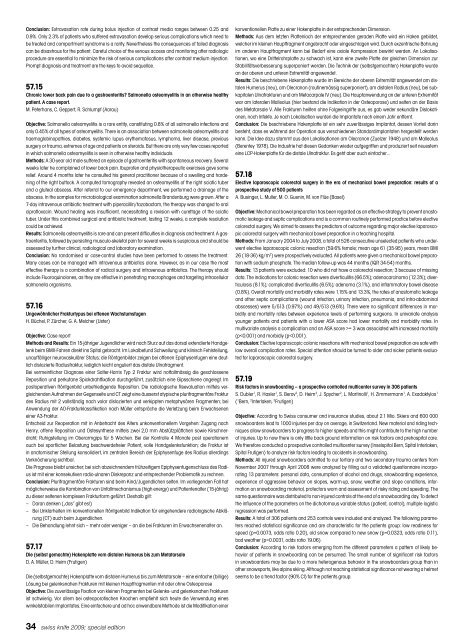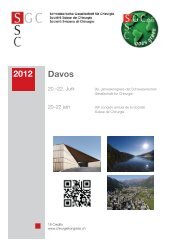Abstracts - Chirurgie Kongress
Abstracts - Chirurgie Kongress
Abstracts - Chirurgie Kongress
Create successful ePaper yourself
Turn your PDF publications into a flip-book with our unique Google optimized e-Paper software.
Conclusion: Extravasation rate during bolus injection of contrast media ranges between 0.25 and<br />
0.9%. Only 2.3% of patients who suffered extravasation develop serious complications which need to<br />
be treated and compartment syndrome is a rarity. Nevertheless the consequences of failed diagnosis<br />
can be disastrous for the patient. Careful choice of the venous access and monitoring after radiologic<br />
procedure are essential to minimize the risk of serious complications after contrast medium injection.<br />
Prompt diagnosis and treatment are the keys to avoid sequellae.<br />
57.15<br />
Chronic lower back pain due to a gastroenteritis? Salmonella osteomyelitis in an otherwise healthy<br />
patient. A case report.<br />
M. Peterhans, C. Geppert, R. Schlumpf (Aarau)<br />
Objective: Salmonella osteomyelitis is a rare entity, constituting 0.8% of all salmonella infections and<br />
only 0.45% of all types of osteomyelitis. There is an association between salmonella osteomyelitis and<br />
haemoglobinopathies, diabetes, systemic lupus erythematosus, lymphoma, liver disease, previous<br />
surgery or trauma, extremes of age and patients on steroids. But there are only very few cases reported<br />
in which salmonella osteomyelitis is seen in otherwise healthy individuals.<br />
Methods: A 30-year old male suffered an episode of gastroenteritis with spontaneous recovery. Several<br />
weeks later he complained of lower back pain. Ibuprofen and physiotherapeutic exercises gave some<br />
relief. Around 4 months later he consulted his general practitioner because of a swelling and hardening<br />
of the right buttock. A computed tomography revealed an osteomyelitis of the right sciatic tuber<br />
and a gluteal abscess. After referral to our emergency department, we performed a drainage of the<br />
abscess. In the samples for microbiological examination salmonella Brandenburg were grown. After a<br />
7-day intravenous antibiotic treatment with piperacillin/tazobactam, the therapy was changed to oral<br />
ciprofloxacin. Wound healing was insufficient, necessitating a revision with curettage of the sciatic<br />
tuber. Under this combined surgical and antibiotic treatment, lasting 12 weeks, a complete resolution<br />
could be achieved.<br />
Results: Salmonella osteomyelitis is rare and can present difficulties in diagnosis and treatment. A gastroenteritis,<br />
followed by persisting musculo-skeletal pain for several weeks is suspicious and should be<br />
assessed by further clinical, radiological and laboratory examination.<br />
Conclusion: No randomised or case-control studies have been performed to assess the treatment.<br />
Many cases can be managed with intravenous antibiotics alone. However, as in our case the most<br />
effective therapy is a combination of radical surgery and intravenous antibiotics. The therapy should<br />
include Fluoroquinolones, as they are effective in penetrating macrophages and targeting intracellular<br />
salmonella organisms.<br />
57.16<br />
Ungewöhnlicher Frakturtypus bei offenen Wachstumsfugen<br />
H. Büchel, P. Zürcher, G. A. Melcher (Uster)<br />
Objective: Case report<br />
Methods and Results: Ein 15-jähriger Jugendlicher wird nach Sturz auf das dorsal extendierte Handgelenk<br />
beim BMX-Fahren direkt ins Spital gebracht. Im Lokalbefund Schwellung und klinisch Fehlstellung,<br />
unauffälliger neurovaskulärer Status; die Röntgenbilder zeigen bei offenen Epiphysenfugen eine deutlich<br />
dislozierte Radiusfraktur, lediglich leicht anguliert das distale Ulnafragment.<br />
Bei vermeintlicher Diagnose einer Salter-Harris Typ 2 Fraktur wird notfallmässig die geschlossene<br />
Reposition und perkutane Spickdrahtfixation durchgeführt, zusätzlich eine Gipsschiene angelegt. Im<br />
postoperativen Röntgenbild unbefriedigende Reposition. Die radiologische Reevaluation mittels vergleichenden<br />
Aufnahmen der Gegenseite und CT zeigt eine äusserst atypische plurifragmentäre Fraktur<br />
des Radius mit 2 vollständig nach volar dislozierten und verkippten metaphysären Fragmenten; bei<br />
Anwendung der AO-Frakturklassifikation nach Müller entspräche die Verletzung beim Erwachsenen<br />
einer A3-Fraktur.<br />
Entscheid zur Reoperation mit in Anbetracht des Alters unkonventionellem Vorgehen: Zugang nach<br />
Henry, offene Reposition und Ostesynthese mittels zwei 2,0 mm Abstützplättchen sowie Kirschnerdraht;<br />
Ruhigstellung im Oberarmgips für 5 Wochen. Bei der Kontrolle 4 Monate post operationem<br />
auch bei sportlicher Belastung beschwerdefreier Patient, volle Handgelenksfunktion; die Fraktur ist<br />
in anatomischer Stellung konsolidiert, im zentralen Bereich der Epiphysenfuge des Radius allerdings<br />
Verknöcherung sichtbar.<br />
Die Prognose bleibt unsicher; bei sich abzeichnendem frühzeitigem Epiphysenfugenschluss des Radius<br />
ist mit einer konsekutiven radio-ulnaren Diskrepanz und entsprechender Problematik zu rechnen.<br />
Conclusion: Plurifragmentäre Frakturen sind beim Kind/Jugendlichen selten. Im vorliegenden Fall hat<br />
möglicherweise die Kombination von Unfallmechanismus (high energy) und Patientenalter (15-jährig)<br />
zu dieser seltenen komplexen Frakturform geführt. Deshalb gilt:<br />
– Daran denken („das“ gibt es!)<br />
– Bei Unklarheiten im konventionellen Röntgenbild Indikation für eingehendere radiologische Abklärung<br />
(CT) auch beim Jugendlichen.<br />
– Die Behandlung lehnt sich – mehr oder weniger – an die bei Frakturen im Erwachsenenalter an.<br />
57.17<br />
Die (selbst gemachte) Hakenplatte vom distalen Humerus bis zum Metatarsale<br />
D. A. Müller, D. Heim (Frutigen)<br />
Die (selbstgemachte) Hakenplatte vom distalen Humerus bis zum Metatarsale – eine einfache (billige)<br />
Lösung bei gelenksnahen Frakturen mit kleinen Hauptfragmenten mit oder ohne Osteoporose<br />
Objective: Die zuverlässige Fixation von kleinen Fragmenten bei Gelenks- und gelenksnahen Frakturen<br />
ist schwierig. Vor allem bei osteoporotischen Knochen empfiehlt sich heute die Verwendung eines<br />
winkelstabilen Implantates. Eine einfachere und ad hoc anwendbare Methode ist die Modifikation einer<br />
34 swiss knife 2009; special edition<br />
konventionellen Platte zu einer Hakenplatte in der entsprechenden Dimension.<br />
Methods: Aus dem letzten Plattenloch der entsprechenden geraden Platte wird ein Haken gebildet,<br />
welcher im kleinen Hauptfragment angebracht oder eingeschlagen wird. Durch exzentrische Bohrung<br />
im anderen Hauptfragment kann bei Bedarf eine axiale Kompression bewirkt werden. An Lokalisationen,<br />
wo eine Drittelrohrplatte zu schwach ist, kann eine zweite Platte der gleichen Dimension zur<br />
Stabilitätsverbesserung superponiert werden. Die Technik der (selbstgemachten) Hakenplatte wurde<br />
an der oberen und unteren Extremität angewendet.<br />
Results: Die beschriebene Hakenplatte wurde im Bereiche der oberen Extremität angewendet am distalen<br />
Humerus (neu), am Olecranon (routinemässig superponiert), am distalen Radius (neu), bei subkapitalen<br />
Ulnafrakturen und am Metacarpale IV (neu). Die Hauptanwendung an der unteren Extremität<br />
war am lateralen Malleolus (hier bestand die Indikation in der Osteoporose) und selten an der Basis<br />
des Metatarsale V. Alle Frakturen heilten ohne Folgeeingriffe aus, es gab weder sekundäre Dislokationen,<br />
noch Infekte. Je nach Lokalisation wurden die Implantate nach einem Jahr entfernt.<br />
Conclusion: Die beschriebene Hakenplatte ist ein sehr zuverlässiges Implantat, dessen Vorteil darin<br />
besteht, dass es während der Operation aus verschiedenen Standardimplantaten hergestellt werden<br />
kann. Die Idee dazu stammt aus den Lokalisationen am Olecranon (Zuelzer 1948) und am Malleolus<br />
(Berentey 1978). Die Industrie hat diesen Gedanken wieder aufgegriffen und produziert seit neuestem<br />
eine LCP-Hakenplatte für die distale Ulnafraktur. Es geht aber auch einfacher…<br />
57.18<br />
Elective laparoscopic colorectal surgery in the era of mechanical bowel preparation: results of a<br />
prospective study of 500 patients<br />
A. Businger, L. Muller, M. O. Guenin, M. von Flüe (Basel)<br />
Objective: Mechanical bowel preparation has been regarded as an effective strategy to prevent anastomotic<br />
leakage and septic complications and is a common routinely performed practice before elective<br />
colorectal surgery. We aimed to assess the predictors of outcome regarding major elective laparoscopic<br />
colorectal surgery with mechanical bowel preparation in a teaching hospital.<br />
Methods: From January 2004 to July 2008, a total of 526 consecutive unselected patients who underwent<br />
elective laparoscopic colonic resection (59.6% female; mean age 61 (35-95) years, mean BMI<br />
26 (18-36) kg/m 2 ) were prospectively evaluated. All patients were given a mechanical bowel preparation<br />
with sodium phosphate. The median follow-up was 44 months (IQR 34-54) months.<br />
Results: 13 patients were excluded: 10 who did not have a colorectal resection; 3 because of missing<br />
data. The indications for colonic resection were diverticulitis (66.5%); adenocarcinoma (12.3%); diverticulosis<br />
(8.1%); complicated diverticulitis (6.5%); adenoma (3.1%), and inflammatory bowel disease<br />
(0.8%). Overall mortality and morbidity rates were 1.15% and 13.3%, the rates of anastomotic leakage<br />
and other septic complications (wound infection, urinary infection, pneumonia, and intra-abdominal<br />
abscesses) were 5/513 (0.97%) and 49/513 (9.6%). There were no significant differences in morbidity<br />
and mortality rates between experience levels of performing surgeons. In univariate analysis<br />
younger patients and patients with a lower ASA score had lower mortality and morbidity rates. In<br />
multivariate analysis a complication and an ASA score >= 3 was associated with increased mortality<br />
(p



